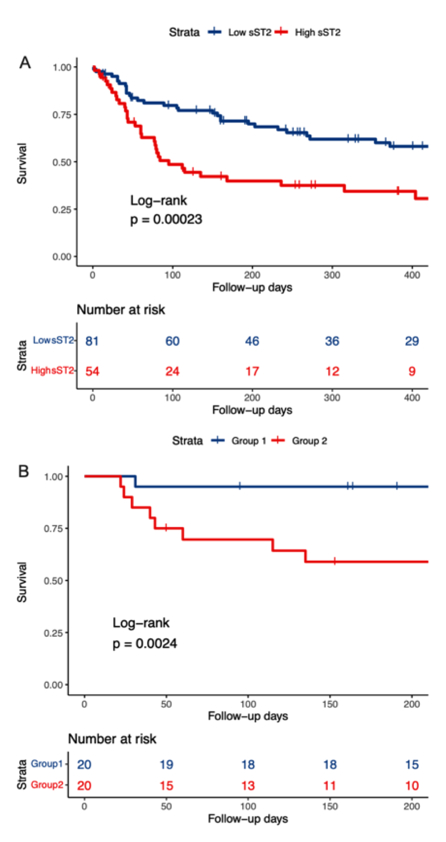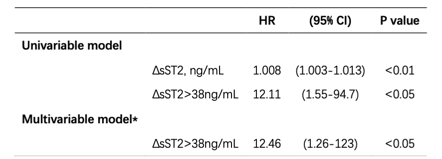Final ID: MDP862
Prognostic Value of Baseline and Change of Soluble Suppression of Tumorigenicity-2 in Light Chain Cardiac Amyloidosis
Abstract Body (Do not enter title and authors here): Background: The predictive value of soluble suppression of tumorigenicity-2 (sST2) has been demonstrated in heart failure patients. However, studies on the association between baseline sST2 levels, dynamic changes in sST2, and prognosis in patients with light chain cardiac amyloidosis (AL-CA) are limited.
Aim: The study sought to assess the predictive value of baseline circulating sST2 and added prognostic value of change in sST2 levels in patients with AL-CA.
Methods: Patients diagnosed with AL-CA patients in Heart Failure Center, Fuwai Hospital between October 2015 to August 2023 were enrolled. The serum sST2 levels were measured at baseline and at 30 days. The change of sST2 (ΔsST2) was defined as the sST2 level at 30 days minus baseline sST2. The primary outcome was all-cause mortality. Kaplan–Meier analysis and Cox hazard models were performed to explore the predictive value of both sST2 at baseline and ΔsST2.
Results: Overall, 132 patients were included. The median follow-up was 235 days. The mean age was 58.92 years (standard deviation [SD]: 10.74 years), and 62.1% of the participants were male. The median sST2 level was 30.42 ng/mL (IQR: 18.41–51.98 ng/mL), with the cutoff value set at 35 ng/mL. Higher sST2 levels at baseline (>35ng/ml) were associated with increased risk of all-cause mortality after adjusting for N-terminal pro–B-type natriuretic peptide (NT-proBNP), cardiac troponin I (cTNI), and difference between involved and uninvolved free light chain (dFLC) levels (adjusted hazard ratio [HR] 1.86, 95% confidence interval [CI]: 1.03-3.38; P<0.05). Among 40 patients with available ΔsST2, a total of 11 primary outcome events occurred. Patients who experienced these events exhibited higher levels of ΔsST2 (median: 193.55 ng/mL, IQR: 100.86-284.86 ng/mL) compared to those who did not (median: 8.04 ng/mL, IQR: -4.69-62.44 ng/mL). Moreover, higher ΔsST2 is also an independent indicator of worse prognosis, even after adjustment for baseline sST2, NT-proBNP, cTNI, and dFLC levels (adjusted HR 12.46, 95% CI: 1.26-123; P<0.05).
Conclusions: Elevated baseline sST2 blood level (>35 ng/L) is a robust and independent indicator of prognosis in AL-CA patients. A dynamic increase in sST2 levels over the short term suggests a dismal prognosis.
Aim: The study sought to assess the predictive value of baseline circulating sST2 and added prognostic value of change in sST2 levels in patients with AL-CA.
Methods: Patients diagnosed with AL-CA patients in Heart Failure Center, Fuwai Hospital between October 2015 to August 2023 were enrolled. The serum sST2 levels were measured at baseline and at 30 days. The change of sST2 (ΔsST2) was defined as the sST2 level at 30 days minus baseline sST2. The primary outcome was all-cause mortality. Kaplan–Meier analysis and Cox hazard models were performed to explore the predictive value of both sST2 at baseline and ΔsST2.
Results: Overall, 132 patients were included. The median follow-up was 235 days. The mean age was 58.92 years (standard deviation [SD]: 10.74 years), and 62.1% of the participants were male. The median sST2 level was 30.42 ng/mL (IQR: 18.41–51.98 ng/mL), with the cutoff value set at 35 ng/mL. Higher sST2 levels at baseline (>35ng/ml) were associated with increased risk of all-cause mortality after adjusting for N-terminal pro–B-type natriuretic peptide (NT-proBNP), cardiac troponin I (cTNI), and difference between involved and uninvolved free light chain (dFLC) levels (adjusted hazard ratio [HR] 1.86, 95% confidence interval [CI]: 1.03-3.38; P<0.05). Among 40 patients with available ΔsST2, a total of 11 primary outcome events occurred. Patients who experienced these events exhibited higher levels of ΔsST2 (median: 193.55 ng/mL, IQR: 100.86-284.86 ng/mL) compared to those who did not (median: 8.04 ng/mL, IQR: -4.69-62.44 ng/mL). Moreover, higher ΔsST2 is also an independent indicator of worse prognosis, even after adjustment for baseline sST2, NT-proBNP, cTNI, and dFLC levels (adjusted HR 12.46, 95% CI: 1.26-123; P<0.05).
Conclusions: Elevated baseline sST2 blood level (>35 ng/L) is a robust and independent indicator of prognosis in AL-CA patients. A dynamic increase in sST2 levels over the short term suggests a dismal prognosis.
More abstracts on this topic:
Acoramidis Improved Clinical Outcomes, Function, Quality of Life and NT-proBNP in Patients With Transthyretin Amyloid Cardiomyopathy Regardless of Atrial Fibrillation Status at Baseline
Sperry Brett, Tamby Jean-francois, Castano Adam, Fox Jonathan, Cheng Richard, Judge Daniel, Cappelli Francesco, Masri Ahmad, Grogan Martha, Mooney Deirdre, Akinboboye Olakunle, Drachman Brian, Nativi-nicolau Jose, Kobayashi Masatake, Chen Chris
A Beta Tubulin Mutation Suppresses Arrhythmias and Improves Connexin 43 Localization in Heart of Duchenne Muscular Dystrophy MiceZhou Delong, Liu Tong, Yehia Ghassan, Romanienko Peter, Rodney George, Wehrens Xander, Lampe Paul, Gourdie Robert, Xie Lai-hua, Fraidenraich Diego, Nouet Julie, Mesa Elam, Yegneshwaran Vasisht, Geukgeuzian Geovanni, Adibemma Ifeanyichukwu, Nandakumar Swetha, Ramirez Edwin, Li Hong



